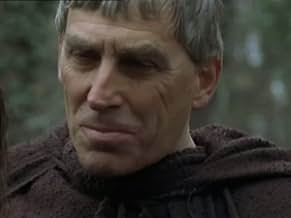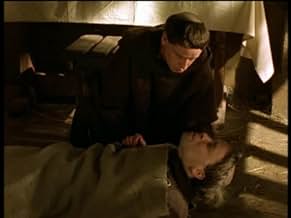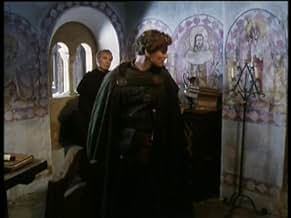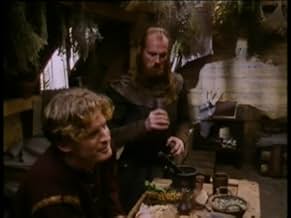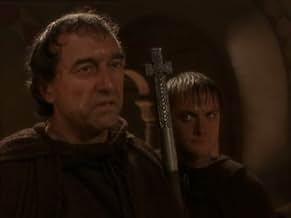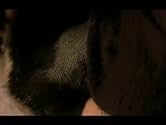Adicionar um enredo no seu idiomaThe medieval era cases of a Crusader-turned-Monk who investigates mysteries in the Norman English town of Shrewsbury.The medieval era cases of a Crusader-turned-Monk who investigates mysteries in the Norman English town of Shrewsbury.The medieval era cases of a Crusader-turned-Monk who investigates mysteries in the Norman English town of Shrewsbury.
Explorar episódios
Avaliações em destaque
This is a great, great show. that manages to mix mystery with an authentic period feel. I have always been interested in the middle ages. i loved this show the first time i saw an episode on PBS. Great mysteries, interesting characters and a good feel for period- although the people are a bit clean most of the time; really love the interplay between Cadfael, standing for logic, rationality, and the power of the human brain to perceive the world and the characters of brother prior/brother Jerome standing for dogma, doctrine and rigid interpretations of the world based on religious hocus pocus. Derek Jacobi shines as brother Cadfael, bringing his wonderful talent to the role and delivering a sterling performance each time. It is so easy to love Cadfael, with his strong sense of justice and dry wit. not to mention his rebellious streak. MUST WATCH!
Even those with criticism for the Cadfael series' inaccuracies and inconsistencies can't help but be avid admirers. The writing and performances are superb and Jacobi must surely be one of the most gifted actors alive on stage or screen.
It seems unnecessary that they had to go abroad to film the series. There must surely be a patch of forest left in Wales or the west of England that would have suited a film crew. It is also a shame that more actual Welsh actors had not been engaged for the series, even as extras or cameos. The location is in a traditionally Welsh region of Shropshire, so one should expect to hear Welsh being spoken by the abbey locals, if not the occasional cast member.
It is true some of the episodes did not work well, especially the incredible "Virgin in the Ice". "The Sanctuary Sparrow" is certainly one of the best due to the classical tragedy of the story. The series is accompanied well on American television by forewords and epilogues by Diana Rigg, usually with interesting trivia about the books, filming or historical background.
It seems unnecessary that they had to go abroad to film the series. There must surely be a patch of forest left in Wales or the west of England that would have suited a film crew. It is also a shame that more actual Welsh actors had not been engaged for the series, even as extras or cameos. The location is in a traditionally Welsh region of Shropshire, so one should expect to hear Welsh being spoken by the abbey locals, if not the occasional cast member.
It is true some of the episodes did not work well, especially the incredible "Virgin in the Ice". "The Sanctuary Sparrow" is certainly one of the best due to the classical tragedy of the story. The series is accompanied well on American television by forewords and epilogues by Diana Rigg, usually with interesting trivia about the books, filming or historical background.
My vote for this series would be an 8 out of 10. It's fairly accurate to the book and I think I actually enjoy the series more. It got rather strange when the actor playing Hugh Beringar kept changing, Sean Pertwee (from the premier season) portrayed him the best. Some of the later episodes fell short of my expectations and sometimes the extras' voices were quite obviously dubbed in, but all in all it was quite an entertaining show.
It was certainly one of the more original mysteries to come to television. I love Jacobi, he's probably one of my favorite actors. I must say my favorite sheriff was Sean Pertwee. Jon Pertwee's son (of Dr. Who fame). I have to agree with Br. Jerome being one you would love to just kick. I think the actor does a bang up job doing so. Are there any more in the series? I would think so, I've only read a handful of the stories. I probably learned more about plants watching this than I ever did on my own. The actor who played the Sargeant, I've seen him before...oh yes, Hitchhiker's Guide I think. So as not to stray too much off topic, I'd actually give Cadfeal a 10/10. I love the program and plan on getting it on DVD.
Well that's my 2 cents.
Well that's my 2 cents.
A literate and highbrow series about a medieval herbalist monk who uses his knowledge to solve crimes. More interesting and much less voyeuristic than CSI and kindred shows.
Most of the previous reviewers did a good job of describing the nature of the series and how truly well acted and off beat it is. Rather than reiterate their commentary, I would like to focus on the show's realistic portrayal of the times. The vast majority of medieval films and/or shows go to inaccurate extremes. In the 50s and 60s, all the women wore brassieres and had Lady Clairol hairdos. The guys were all clean shaven Brylcream men with slicked back pompadours. And everyone's clothes looked freshly pressed and drycleaned. In the 70s, the trend went to the other extreme. All, even the well off, were dressed in filthy, tattered clothes and looked as if they did indeed bathe daily---in a vat of manure. Lots of teeth were missing from every mouth and every face covered with running sores. There was no middle ground between the squeaky clean people and places of the 50s "Robin Hood" series (a good adventure show nonetheless) and the comically exaggerated filth and squalor of Monty Python's "Jabberwocky."
The Cadfael series provided that balance. The set designs and costumes were very accurate renderings of what actually existed at the time, and the series credibly demonstrated how people of that era went about their daily business and social lives. Many, especially the poor, were certainly ragged and unkempt, but few, rich or poor, were oblivious to the appearance of their homes or themselves. Another aspect of this show missing from most similar efforts was it's attempt to show how the tradespeople and middle class of the time worked and lived. Most "medieval" films perpetuate the myth that society was strictly divided into "have everythings" and "have nothings". Everyone is either an aristocrat or a starving, oppressed serf dressed in rags. This show actually gives the viewer an idea of how much more varied and complex medieval society really was.
A first rate show, even more so for the historically literate. Although some of the later episodes hobbled their plots with ponderous soap opera "blasts from the past" from Cadfael's former life as a crusader, I was sad to see the series end. I never read any of the books, but understand that there are still a few that have not been filmed. I would love to see the series revived, although this winning combination of casting and production would be hard to repeat and harder still to beat.
Most of the previous reviewers did a good job of describing the nature of the series and how truly well acted and off beat it is. Rather than reiterate their commentary, I would like to focus on the show's realistic portrayal of the times. The vast majority of medieval films and/or shows go to inaccurate extremes. In the 50s and 60s, all the women wore brassieres and had Lady Clairol hairdos. The guys were all clean shaven Brylcream men with slicked back pompadours. And everyone's clothes looked freshly pressed and drycleaned. In the 70s, the trend went to the other extreme. All, even the well off, were dressed in filthy, tattered clothes and looked as if they did indeed bathe daily---in a vat of manure. Lots of teeth were missing from every mouth and every face covered with running sores. There was no middle ground between the squeaky clean people and places of the 50s "Robin Hood" series (a good adventure show nonetheless) and the comically exaggerated filth and squalor of Monty Python's "Jabberwocky."
The Cadfael series provided that balance. The set designs and costumes were very accurate renderings of what actually existed at the time, and the series credibly demonstrated how people of that era went about their daily business and social lives. Many, especially the poor, were certainly ragged and unkempt, but few, rich or poor, were oblivious to the appearance of their homes or themselves. Another aspect of this show missing from most similar efforts was it's attempt to show how the tradespeople and middle class of the time worked and lived. Most "medieval" films perpetuate the myth that society was strictly divided into "have everythings" and "have nothings". Everyone is either an aristocrat or a starving, oppressed serf dressed in rags. This show actually gives the viewer an idea of how much more varied and complex medieval society really was.
A first rate show, even more so for the historically literate. Although some of the later episodes hobbled their plots with ponderous soap opera "blasts from the past" from Cadfael's former life as a crusader, I was sad to see the series end. I never read any of the books, but understand that there are still a few that have not been filmed. I would love to see the series revived, although this winning combination of casting and production would be hard to repeat and harder still to beat.
Você sabia?
- CuriosidadesSeveral of the names and occupations of the monks in the series are actually from a record book from the Abbey of St. Peter and St. Paul in Shrewsbury, England. Some of these include Cadfael, Robert, Jerome, and Heribut.
- Erros de gravaçãoFemale characters are invariably exquisitely made up with the most modern tones of foundation, blusher and lipstick. After HD was introduced this became more noticeable.
- ConexõesFeatured in Drama Trails: 'Secret Diary of a Call Girl' to 'London's Burning' (2008)
Principais escolhas
Faça login para avaliar e ver a lista de recomendações personalizadas
Detalhes
Contribua para esta página
Sugerir uma alteração ou adicionar conteúdo ausente








